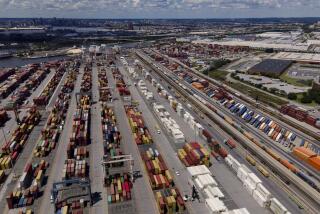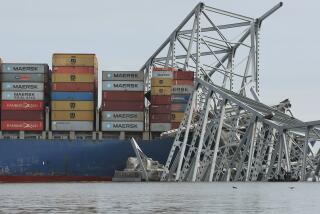L.A./Long Beach ports struggle to meet Panama Canal challenge
A major expansion of the Panama Canal is raising alarms in Southern California, where business, labor and public officials are warning that the project threatens to dent the region’s role in international trade.
The $5.25-billion project will make the canal wider and deeper, allowing huge freighters from Asia to bypass West Coast ports and head straight to terminals on the Gulf Coast and East Coast. The neighboring ports of Los Angeles and Long Beach, which together handle about 40% of the nation’s imported Asian goods, could lose as much as a quarter of their cargo business by some estimates after the Panama expansion is completed in 2014.
The ports, neighboring towns and railroads have launched improvement projects aimed at keeping them competitive. One proposed project, for instance, would speed the loading of cargo onto trains; others eliminate bottlenecks or increase capacity so that the ports remain alluring to importers. But a coalition of business, labor and government contends that these efforts are jeopardized by opposition from some residents, environmental groups and others.
Two members of the Long Beach City Council, for example, sought to block the construction of a new railroad freight complex near the ports, saying it would increase pollution and force small businesses to relocate.
The coalition, which calls itself the Jobs 1st Alliance, says the rail and other projects are crucial if Southern California hopes to keep its place as a center for international trade. Directly and indirectly, economists say, cargo movement employs more than 500,000 people in the region.
“To protect these jobs, we need to get these projects completed,” said Wally Baker, president of the alliance and a former executive with the Los Angeles County Economic Development Corp., a jobs promotion group. “But every time it looks as though progress is being made, someone tries to move the finish line.”
The coalition has launched a campaign called Beat the Canal, using Facebook and a website (BeatTheCanal.com), and plans to act as an advocate for specific projects, pushing for faster action and fighting against environmental and other reviews that become excessive, Baker said.
One of those on board is Maria Elena Durazo, executive secretary-treasurer of the Los Angeles County Federation of Labor.
“We’re trying to put the point across that business and government and labor need to be on the same page,” she said. “We need to work together and recognize the ports for their broader importance to the economy of Southern California.”
Few places host a system as complex as the Southern California seaports and the vast regional network of truck routes, rail lines, bridges, freeways and warehouses that serve it. The ports of Los Angeles and Long Beach are the biggest U.S. port complex and the world’s sixth-busiest harbor.
The Jobs 1st Alliance fears that the ports could lose as many as 100,000 jobs when the Panama Canal overhaul allows much larger ships to bypass California.
“Worst case, there could be a 25% diversion from Los Angeles-Long Beach,” said Paul Bingham, the group’s chief economist. “That’s upwards of 3 million cargo containers. That’s a lot of dockworkers who don’t get work, truckers with less to haul and trains that don’t run.”
The biggest ships that can squeeze through the Panama Canal now carry 4,400 to 5,000 containers. But modern cargo vessels routinely hold three times as many of the big metal boxes.
So importers often use West Coast ports to land their products from Asia. Then the containers crammed with apparel, toys and other goods move from ships to trucks or trains and on to warehouses and retailer shelves throughout the U.S.
A wider Panama Canal would accommodate some of the biggest ships afloat — 12,600-container vessels — which will present a vastly improved “all water” cargo movement option for Asian goods bound for the southern and eastern U.S.
Jobs 1st Alliance is worried by the efficiency that Panamanian authorities have shown in keeping the project on schedule and their zeal in pursuing business with other ports, Baker said.
By contrast, U.S public and private efforts launched in response to the Panama project are being slowed by red tape and lawsuits, said Baker, who noted that he has lent Jobs 1st Alliance about $200,000 of his own money. The group does no lobbying and is registered with the Internal Revenue Service as a 501(c)(4) social welfare organization, Baker said.
So far, Baker said, he’s recouped about half of the loan from donations from Alliance members, such as the International Brotherhood of Electrical Workers Local 11, the International Longshore and Warehouse Union, BNSF Railway, Union Pacific, the Southern California Assn. of Governments and the Southern California Leadership Council.
The biggest share of the money — $65,000 — went to produce a video the group has on its website that makes the case for expediting infrastructure improvements. It ends with several politicians and others, even Mary Nichols, chairwoman of the California Air Resources Board, chanting, “Beat the canal.” She is joined by the likes of Los Angeles Mayor Antonio Villaraigosa, former Gov. Gray Davis, former Assembly Speaker Willie Brown and business leaders such as Greg McWilliams, president of Newhall Land & Farming Co.
Other efforts include an assessment of every project underway involving competing ports.
About 65 projects totaling about $7.5 billion need to be expedited to keep Southern California on top, Baker said. Among those is BNSF Railway’s Southern California International Gateway Project, designed to speed rail movement and reduce truck traffic and diesel emissions.
The project was proposed in 2005. But its 4,690-page draft environmental impact report wasn’t completed for six years, a measure of the difficulty answering the objections.
And it’s still not adequate, said Long Beach City Council members Rae Gabelich and James Johnson, who introduced a memorandum this month opposing the location of the yard.
The council meeting drew a crowd of Jobs 1st Alliance representatives, mostly union workers, to argue against the memorandum. The council voted to request more information from the ports about other possible locations and how many businesses would need to relocate.
Opponents of some of the projects say they are concerned because port-side neighborhoods already bear an inordinate burden of air pollution and traffic.
Community activist Jesse Marquez said that not enough had been done to assess health effects of various projects.
“How can the ports mitigate public health impacts when they do not know how many people are already sick, with what illness, the degree of illness and the cost of healthcare?” he said.
The Natural Resources Defense Council contends “giving people an either-or, promoting jobs or promoting public health, is a false choice,” said Melissa Lin Perrella, a senior attorney at the council. “The environmental review processes are important and make sure that these projects provide good jobs and protect public health.”
Baker says his group isn’t promoting a full-speed-ahead agenda that would sacrifice public health.
“We’re doing this to show people there is a threat to our regional economy and that we can do something about it,” Baker said. “Who’s the target? The target is anyone who doesn’t believe that we have to be more competitive.”







